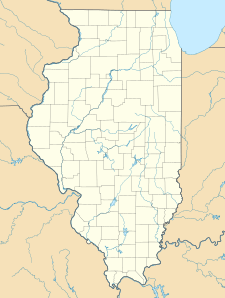William W. Powers State Recreation Area facts for kids
Quick facts for kids William W. Powers State Recreation Area |
|
|---|---|
|
IUCN Category V (Protected Landscape/Seascape)
|
|
| Location | Chicago, Cook County, Illinois, United States |
| Nearest city | Chicago, Illinois |
| Area | 580 acres (230 ha) |
| Established | 1947 |
| Governing body | Illinois Department of Natural Resources |
The William W. Powers State Recreation Area is a cool state park located in Chicago, Illinois. It's managed by the Illinois Department of Natural Resources. The park covers about 580 acres, which is a huge space for outdoor fun!
A big part of this park is Wolf Lake. About 419 acres of the park is water from this lake. It offers around 6 miles of shoreline, which is perfect for people who love to fish. Many visitors come to the park each year, making it a very popular spot. This area is also super important for nature, as it's home to many different kinds of plants and animals.
Contents
Park History and Name
Wolf Lake in Illinois has a long and interesting past. No one is quite sure how the lake got its name, but it has been called Wolf Lake for over 150 years! Even Abraham Lincoln visited this area a long time ago.
In 1947, the state bought 160 acres of land around Wolf Lake. More land was added later, and the area became known as the Wolf Lake Conservation Area. In 1965, the Illinois General Assembly decided to name the park after William W. Powers. He was a local leader in Chicago. During the Great Depression, a time when many people needed help, William W. Powers used this site to hold picnics and feed those who were hungry.
The park also has a military past. There is a special memorial for a Nike Ajax missile site. This site was used during the Cold War years. On holidays like Memorial Day and Veterans Day, people gather here to honor veterans. They place flags near markers that remember those who served.
Unlike the sandy shores of Lake Michigan, Wolf Lake was partly filled with a material called slag. This slag came from nearby steel mills.
Amazing Wildlife at Wolf Lake
Wolf Lake is full of different kinds of fish! You can find largemouth bass, northern pike, bluegill, crappie, and walleye. Sometimes, people even catch salmon and rainbow trout in the lake. These fish can swim into Wolf Lake from the Calumet River.
Birds of Wolf Lake
Many types of swans visit Wolf Lake in the winter. These include native trumpeter swans and tundra swans. You might also see non-native mute swans. Tundra swans fly far north to nest in the summer. However, mute swans stay year-round and can compete with the native trumpeter swans.
Other native birds you can spot include cardinals, blue jays, finches, woodpeckers, teal, and mallards. You can also see Canada geese and sometimes even a bald eagle!
Birdwatchers enjoy seeing the non-native monk parakeets. These colorful parrots are from South America. They started nesting in the park around 1999. Hunters also come to the park during certain seasons to hunt waterfowl.
Plants and Mammals
The park has many willow and cottonwood trees. These trees provide homes for animals.
You can also find many city-dwelling mammals here. These include squirrels, rabbits, raccoons, muskrats, and opossums. Sometimes, you might even see a coyote or a white-tailed deer. There are also signs that beavers are living in the lake.
The Calumet BioBlitz
On August 23, 2002, Wolf Lake was part of a special event called the Calumet BioBlitz. Over 150 expert scientists came together for 24 hours. Their goal was to find and record as many living things as possible. This event showed how nature can thrive even near factories and highways. The BioBlitz unofficially counted 1,815 different species! Scientists from many universities and organizations took part.
Wolf Lake is also home to some rare species. The lake sturgeon is an endangered fish in both Indiana and Illinois. The banded killifish is also threatened in Illinois. The lake provides nesting spots for four types of endangered birds: the little blue heron, yellow-crowned night heron, black-crowned night heron, and yellow-headed blackbird.
Protecting Wolf Lake
Many groups are working to keep Wolf Lake healthy. The U.S. Army Corps of Engineers and the Illinois Water Survey are studying ways to stop the lake from getting worse. The USDA Forest Service is also looking at how people use the lake for fun.
The water level in Wolf Lake affects how water flows to Lake Michigan. In 1998, the Illinois Department of Natural Resources removed some beavers and their dams. This caused the water level to drop, which led to more weeds growing.
In 1998, the Illinois Department of Natural Resources and the city of Hammond, IN started a plan to help the lake. They found that the lake had many problems. These included too many non-native plants, not enough different types of plants and fish, and poor water depth. The plan suggests planting new water plants, restoring the shoreline, and creating deeper areas in the lake. They also plan to clear channels and build dikes to bring back natural water levels.
What You Can Do at the Park
The William W. Powers State Recreation Area is a great place for outdoor activities! You can reserve shelters and use stoves for picnics. Some shelters can hold 50 people, and others can hold 100.
Fishing and hunting are allowed, but you need to follow the rules. However, camping is not permitted in the park. In winter, you can go ice fishing. During summer, you can use motorboats with up to 10 horsepower on the lake. The lake has special dikes that help control the waves.
For hunters, there are 25 special spots called hunting blinds to hunt waterfowl. These spots are given out in a lottery each year.
Many volunteers help keep the park clean and safe. For example, on Earth Day in 2001, over 350 volunteers helped clean up the lake. They removed about 36,000 pounds of trash! Another group collected more than 3,000 old tires from the lake. Local clubs and organizations often work with scouts and community groups to organize cleanups twice a year.
Park Location and Size
Wolf Lake stretches across the border between Illinois and Indiana. It is located between 120th and 134th streets. The lake is about 804 acres in total. About 419 acres of the lake are in Chicago, Illinois. The rest is in Hammond, Indiana. The deepest part of the lake is about 20 feet.
Near the lake, there are other natural areas. These include Eggers Woods Forest Preserve, Powderhorn Lake Prairie, and Hyde Lake Wetland. The William W. Powers State Recreation Area is on the far southeast side of Chicago. You can get there easily from highways 94, 90, and 41. The main entrance is at 12949 South Avenue O.
Wolf Lake used to be connected to Lake Michigan by a creek. But this creek is now blocked by buildings. On the Illinois side, Wolf Lake flows into Indian Creek, which then goes into the Calumet River. The Illinois and Indiana parts of the lake are separated by a rock-and-gravel path called State Line Road. This path ends where foot bridges allow water to flow from the Indiana side.



